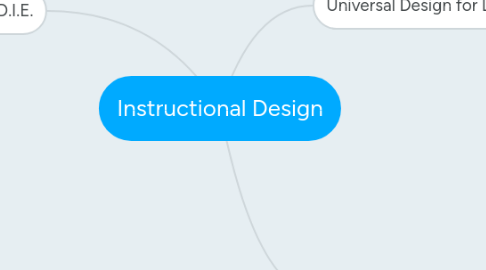
1. A.D.D.I.E.
1.1. Analysis
1.1.1. Learner
1.1.1.1. Check in all year
1.1.1.1.1. Interests
1.1.1.1.2. Attitude about subject
1.1.1.1.3. Background knowledge
1.1.1.2. Check at the beginning
1.1.1.2.1. Demographics
1.1.1.2.2. Culture
1.1.1.2.3. Language
1.1.1.2.4. Age
1.1.1.2.5. Favorite subjects
1.1.1.2.6. Services available
1.1.2. Content
1.1.2.1. Self-assess on content knowledge
1.1.2.2. Standards and district standards
1.1.2.3. Internet research
1.1.2.4. Curricular materials / PowerPoints available
1.1.2.5. Synthesize, organize, weed and select
1.1.3. Task
1.1.3.1. Purpose
1.1.3.1.1. Determine instructional goals and objectives
1.1.3.1.2. Define and describe tasks and sub-tasks that students will perform
1.1.3.1.3. Specify the knowledge type that characterize a job or task
1.1.3.1.4. Select learning outcomes that are appropriate for instructional development
1.1.3.1.5. Prioritize and sequence tasks
1.1.3.1.6. Determine instructional activities and strategies that foster learning
1.1.3.1.7. Select appropriate media and learning environments
1.1.3.1.8. Construct performance assessments and evaluation
1.1.3.2. Types
1.1.3.2.1. Job or performance analysis
1.1.3.2.2. Cognitive tasks analysis
1.1.3.2.3. Activity analysis
1.1.3.2.4. Content or subject matter analysis
1.1.3.2.5. Learning analysis
1.1.3.3. Formats
1.1.3.3.1. Procedural
1.1.3.3.2. Hierarchical or prerequisite
1.1.3.3.3. Information processing
1.1.3.3.4. Cluster
1.1.3.3.5. Conceptual graph
1.1.4. Resource
1.1.4.1. Technology
1.1.4.2. Money
1.1.4.3. Textbooks
1.1.4.4. Parental involvement/community
1.1.4.5. Physical space
1.1.4.6. Specialists
1.1.4.7. Transportation
1.1.4.8. Additional services
1.1.4.9. Geographic opportunities
1.1.4.10. Teacher-to-student ratio
1.1.4.11. Staff
1.1.5. Context
1.1.5.1. Performance: where will skills and knowledge be used?
1.1.5.2. Learning: facilities, limitations of setting that affect instruction
1.2. Design
1.2.1. Learning objectives
1.2.1.1. Ways to analyze/organize objectives
1.2.1.1.1. Terminal (long-term, higher order) v. enabling (component skills, help reach terminal)
1.2.1.1.2. Cognitive, affective, psychomotor (physical), interpersonal
1.2.1.1.3. Bloom's Taxonomy
1.2.1.1.4. Webb's Depth-of-Knowledge Levels
1.2.1.2. Methods of writing objectives
1.2.1.2.1. ABCD Model
1.2.1.2.2. PCC Model
1.2.1.2.3. "Guide to Writing Learning Objectives"
1.2.2. Sequencing instruction
1.2.2.1. Chronological
1.2.2.2. Topical: topic -> origins of problem or if it's not solved
1.2.2.3. Whole-to-part: whole picture presented first
1.2.2.4. Part-to-whole
1.2.2.5. Known-to-unknown
1.2.2.6. Unknown-to-known
1.2.2.7. Step-by-step (for task/process)
1.2.2.8. Part-to-part-to-part: shallow, then back around for deeper--spiral; introduce topic then build
1.2.2.9. General-to-specific: same foundation, then specialize
1.2.3. Essential questions and enduring understandings
1.3. Development
1.3.1. Gagne's 9 Events of Instruction
1.3.1.1. Graphic
1.3.1.2. Helpful guide
1.3.2. Helpful videos
1.3.2.1. Planning
1.3.2.2. Improving Pacing
1.3.2.3. Pace and Structure in Lesson Planning
1.3.3. Gradual Release of Instruction
1.3.3.1. I do it (direct instruction)
1.3.3.2. We do it (guided instruction)
1.3.3.3. You do it (independent practice)
1.3.3.4. You do it together (collaborative learning)
1.4. Implementation
1.4.1. Strategies to improve transitions and time management
1.4.2. Streamlining procedures and ensuring proficiency
1.4.3. Managing transitions
1.4.4. Getting their attention
1.5. Evaluation
1.5.1. Types of evaluation
1.5.1.1. Formative: part of the learning process, used to guide teaching and activities to approve student attainment
1.5.1.1.1. Questionaires
1.5.1.1.2. Polls
1.5.1.1.3. Classwork, exit ticket
1.5.1.1.4. Research proposal
1.5.1.1.5. One of two sentences to demonstrate understanding
1.5.1.2. Summative: focuses on the outcome of a whole program
1.5.1.2.1. Midterm
1.5.1.2.2. Final project
1.5.1.2.3. Paper
1.5.1.2.4. Senior recital
1.5.2. Assessment tools
1.5.2.1. SMART Response (clickers and SmartBoard)
1.5.2.2. Turning Point (clickers)
1.5.2.3. Google forms
1.5.2.4. Socrative (mobile device or computer)
2. Universal Design for Learning
2.1. Overview
2.2. Framework - equal opportunity!
2.2.1. Provide multiple means of representation
2.2.1.1. Provide options for perception, language, mathematical expression, symbols, comprehension
2.2.1.2. You'll get resourceful, knowledgable learners
2.2.2. Provide multiple means of action and expression
2.2.2.1. Provide options for physical action, expression and communication, and executive functions (goal-setting, information and resource managing, etc.)
2.2.2.2. You'll get goal-directed, strategic learners
2.2.3. Provide multiple means of engagement
2.2.3.1. Provide options for recruiting interest (optimize autonomy), sustaining effort and persistence, self-regulation
2.3. UDL v. differentiated instruction
2.3.1. Differentiated instruction is a strategy that focuses on the learner and making adjustments in instruction based upon the needs of the learner
2.3.1.1. Content
2.3.1.2. Process
2.3.1.3. Product
2.3.2. UDL focuses on eliminating learning barriers in the curriculum, instruction and assessment from the onset to maximize number of students who benefit
3. Understanding by Design
3.1. In A Nutshell
3.2. Key points
3.2.1. Curriculum is planned backwards with long-term desired result in mind
3.2.2. Make meaning via learning the big ideas
3.2.3. Three-stage design process
3.2.3.1. Identify desired results
3.2.3.2. Determine acceptable evidence
3.2.3.2.1. Performance tasks v. other evidence
3.2.3.2.2. Six facets of understanding
3.2.3.3. Plan learning experiences and instruction
3.2.3.3.1. Where and why
3.2.3.3.2. Hook and hold
3.2.3.3.3. Explore and experience, enable and equip
3.2.3.3.4. Reflect, rethink, revise
3.2.3.3.5. Tailor and personalize the work
3.2.3.3.6. Organize for optimal effectiveness

